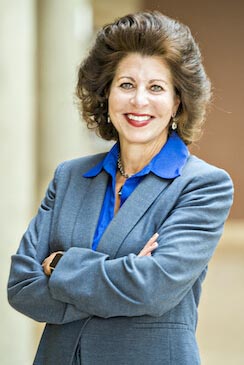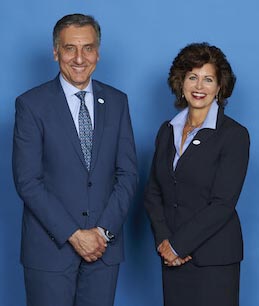Environmental engineering alumna leads through inclusivity and communication
10/27/2021
By Tim Schley
UNIVERSITY PARK, Pa. — As one of the few women who have had the opportunity to run a Fortune 500 company, distinguished Penn State engineering alumna Jacqueline Hinman understands the value of self-advocacy. To her, it is one part of a two-way communication skill set that helped her reach the highest echelon of a historically male-dominated industry.
“The skill to be able to read other people and listen to their needs while communicating your own has probably taken me farther than anything else,” said Hinman, who graduated from Penn State with a bachelor’s degree in environmental engineering in 1983. She was elected chairman and chief executive officer of engineering and construction firm CH2M in 2014 and served in that role until the company merged with Jacobs Engineering in 2017. Now, Hinman is a director on the boards of AECOM, Dow Chemical and International Paper.
Early in her career, Hinman was assigned as an on-site manager overseeing the construction of a hazardous waste landfill. As a Penn State-educated engineer, she had helped design the project, but that did not stop the construction contractor staff from directing her to the trailer for administrative work.
“I went to one of the older operators of the machinery and asked, ‘What do I have to do to earn their trust?’” said Hinman, who, as the daughter and granddaughter of engineers and construction laborers, had some familiarity with the inner workings of the industry. “And he said, ‘Well, first you have to earn their respect.’”
According to Hinman, the operator told her the crew likely viewed her as unqualified since she did not have the specific boots-on-the-ground construction experience they had — and would likely assume a male supervisor would have. He predicted the crew would respect her more if she could demonstrate project management and on-site skills, including the operation of the bulldozer. So, Hinman asked him to teach her, and every night for two weeks, they practiced using the equipment after everyone had left. Then, she approached the crew to begin navigating the issues.
“The guys said, ‘You don’t know what you’re doing,’ and the operator who trained me said, ‘How do you know she doesn’t know about construction?’” Hinman said. “I got in and operated the dozer for about 15 minutes, and the rest is history.”
Hinman joined CH2M in 1988, starting in their environmental department. She rose through the ranks, working in a variety of departments until she started her own consulting firm in 1997.
“I always took on the thing that nobody else wanted to do,” Hinman said. “I asked a lot of questions and learned about the different parts of the project that create value.”
Value is in the eyes of the beholder, according to Hinman. Young engineers could not only benefit from taking on different projects but also asking managers how success would be defined, she explained.
“Often times, we say ‘This is successful if it is built in this timeframe and in this budget,” she said. “I would encourage people to be more inquisitive. Is it successful if it creates more jobs? Is it successful if the community can enjoy it one more month per year? It is a great opportunity to ask, ‘What are the one or two things I should look at as a young professional to create more value?’”
Hinman was recruited back to CH2M in 2003 and served in several top-level management positions. She led global construction projects such as the 2012 London Olympic and Paralympic Games, the Panama Canal expansion and the launch of Masdar City, a sustainability showcase in Abu Dhabi, United Arab Emirates.
In her time as CEO, Hinman led with an inclusive approach. By the time the company merged and she stepped down, approximately one-half of CH2M’s employees and one-third of the board of directors were women.
Hinman added that although the workplace has evolved since her early days in the industry, there are still disparities, especially regarding salary and work-life balance. To help change these differences, Hinman recommended self-advocacy.
“People often do not know how to stand up for themselves,” she said. “Do not be afraid to appropriately say, ‘This is what I want,’ ‘This is how I would like to add value,’ and, ‘I would like to be treated equally.’”
Self-advocacy is one direction in the two-way communication that Hinman has used to build her career. It works best when the person in power is receptive to change, but employees can also gather the support of allies and other advocates, such as the machine operator who assisted Hinman, to bolster their appeal for equity.
“In those times, had I not had somebody who was willing to help me, I could never have done that,” Hinman said.





